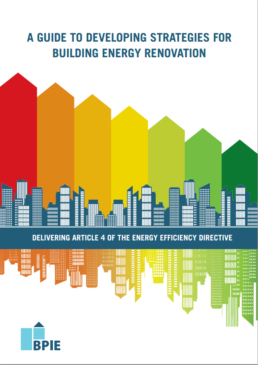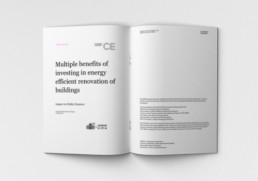European Parliament endorses Renovate Europe's long-term target on building renovations
The European Parliament's Report on the Energy Roadmap 2050 stresses that the reduction of energy use in buildings must be a "central element" of the EU's long-term energy policy, and calls for a reduction in the energy consumption of the existing building stock "by 80% by 2050 compared to 2010 levels", in line with the Renovate Europe Campaign vision.
The own-initiative report on the Commission's Energy Roadmap 2050 was adopted in Plenary today, 14th March 2013, following a vote in the ITRE Committee on 24th January.
“There is no doubt about it – we urgently need to address the energy efficient renovation of the EU building stock. With poor performing buildings, we are not only wasting energy and money, but we are also missing out on a golden opportunity to deliver on the EU’s climate change, jobs, growth and energy security goals” explained Shadow Rapporteur Fiona Hall (ALDE – UK). “With this Roadmap, Parliament is sending out a strong message to the Commission and to the Member States to take decisive measures to substantially scale up the rate and quality of building renovation in Europe.”
This ambitious yet achievable building renovation target, which received cross-party support in the ITRE Committee vote in January, is recognized as essential to provide market certainty needed in order to unleash investment in the building renovation sector. This building renovation target is in line with the call for a set of mutually reinforcing post-2020 targets for greenhouse gas emissions, renewable energy and energy efficiency, also enshrined in the Parliament’s Roadmap.
The need for a long-term target for the buildings sector was already established as a cornerstone of the EU Roadmap for moving towards a Low-Carbon economy in 2050, agreed in 2011, and is re-iterated in the recently adopted Energy Efficiency Directive, which calls on Member States to adopt ambitious longterm building renovation strategies.
“Over and over again, we are hearing the need to establish a long-term target for the building sector in order to unlock investment. This call for a long-term vision for reducing the energy demand in buildings must be taken into account as the Commission considers new energy and climate actions post-2020”, highlighted Adrian Joyce, Campaign Director of the Renovate Europe Campaign.
A Guide to Developing Strategies for Building Energy Renovation
BPIE has produced a guide to support the EU Member States draft the first version of their renovation strategies to be published by April 30th 2014.
Deep renovations are specifically encouraged by the Energy Efficiency Directive (EED, 2012/27/EU) through the requirement for Member States to establish long term strategies for the renovation of national building stocks covering all building types, including residential and non-residential buildings, whether in private, public or mixed ownership. The adoption of the EED in October 2012, developed in order to help deliver the EU’s 20% headline target on energy efficiency by 2020, as well as to pave the way for further improvements thereafter, provides the regulatory drive around which to define a body of support to achieve this long-term ambition. (EED, article 4 requirements on building renovation)
Alongside the EED, the Energy Performance of Buildings Directive (EPBD, 2010/31/EU), recast in 2010, sets out numerous requirements including energy performance certification of buildings, inspection regimes for boilers and air conditioning plants, and requirements for new buildings to be nearly zero energy. The EPBD sets minimum energy performance standards for buildings undergoing renovation. Together, the EED and EPBD provide a framework for Member States to drive the reduction of energy use in buildings, thereby delivering a range of economic, environmental, societal and energy security benefits.
This guide is a template that can be used for strategy development, setting out the multiple benefits arising from improving the energy performance of buildings. It highlights the existence of numerous challenges to the achievement of the potential benefits. It argues for Member States to be visionary in setting out a long term strategy for building stock renovation: it is vital that national renovation strategies are ambitious in their scope and coverage, and that they take full advantage of the state of the art, in terms of technology, policy and institutional arrangements. The strategy development process is described in details, including a description of the five key phases and a suggested list of actions MS could take to underpin the strategy.
BPIE aims to work with Member State representatives over the coming year to help ensure national renovation strategies deliver their full economic potential, as well as to create knowledge and awareness around best practice in renovation strategy development and delivery.
Renovate Europe welcomes Parliament's call for ambitious building stock renovation targets!
The European Parliament’s Report on the Energy Roadmap 2050, adopted in the ITRE Committee on 24th January, echoes the call already voiced in the EU Roadmap for a low-carbon economy in 2050 as well as in the Energy Efficiency Directive, to urgently address the energy efficient renovation of Europe’s buildings.
The own-initiative report on the Commission’s Energy Roadmap 2050 underlines the need to substantially scale up the rate and quality of building renovation in order to reduce the energy consumption of the existing building stock “by 80% by 2050 compared to 2010 levels”.
“Energy Efficiency is a cost-effective way for Europe to achieve its long-term energy-saving, climate change, economic and energy security goals”, reads the text of the Report. It recognizes the huge energy savings potential and economic benefits which currently lie dormant in the EU’s low-performing building stock, and reiterates the key role which energy efficiency must play in the EU’s needed energy transition towards a competitive low carbon and low energy future.
Achieving the reduction in energy demand of the EU’s building stock by 80% by 2050 was already established as a cornerstone of the EU Roadmap for moving towards a Low-carbon economy in 2050, agreed in 2011. Setting this long-term perspective for energy efficiency is essential to providing market certainty in the long-term, to unleash the needed investment in energy efficiency.
“Aligning all actors, in the public and private sector, but also at consumer level, around the same goals of reducing the energy demand of the EU’s existing building stock by 80% by 2050 is a fundamental step to achieving the EU’s goal of a competitive low-carbon and low-energy economy by 2050”, explained Adrian Joyce, Campaign Director of the Renovate Europe Campaign. “The Renovate Europe Campaign recognized this logical step in 2011, and set this target as the main vision of its Campaign, with the aim of delivering jobs, growth and lower energy bills for EU citizens.”
The Parliament’s Report also calls on the Member States to fully implement the recently adopted Energy Efficiency Directive, and to adopt ambitious long-term building renovation strategies accordingly.
80% of the Economic Potential of Energy Efficiency in buildings still untapped World Energy Outlook 2012, IEA
In its World Energy Outlook 2012 (WEO), launched in Brussels on 20th November, the International Energy Agency (IEA) underlines the unexploited potential of energy efficiency in terms of economic gains, energy security improvements and environmental protection.
The multiple benefits of energy efficiency could be achieved if the currently available technologies and practices to improve energy efficiency were systematically adopted, leading to “energy savings, by 2035, equivalent to nearly a fifth of global demand in 2010”, according to IEA Executive Director Maria van der Hoeven. “Energy efficiency is just as important as unconstrained energy supply” she explained. Referring to the buildings sector, the WEO deplores the fact that 80% of the economic potential of energy efficiency in buildings remains untapped, largely due to non-technical barriers.
As the EU’s increased dependence on imported energy is predicted to reach record levels of over 80% by 2035, the urgency to reduce the energy demand of the EU building stock is imminent. Indeed, as the sector responsible for 40% of all energy consumed in Europe, the buildings sector is highlighted by the WEO as the sector with the highest energy efficiency potential.
“Renovating Europe’s building stock has a significant mitigating potential and undeniable economic benefits” said Adrian Joyce, Director of the Renovate Europe Campaign. “The facts are there, and the technology is available! Let’s work together to seize this opportunity for every Member State to reap the benefits of greater energy security, increased economic activity and lower energy bills for their citizens.”
The figures released by the WEO lend further support to the Renovate Europe Campaign’s objectives of reducing the energy demand of the energy demand in buildings by 80% by 2050. The findings of the Multiple Benefits Study launched at Renovate Europe Day 2012 echo the WEO’s analysis of the need to act on the renovation of our building stock in order to harvest the economic, environmental and societal benefits that such action will bring.
Eco-renovations will boost states' coffers - study
EU governments could raise up to €128bn by 2017 through additional income and corporate taxes and lower social costs from renovation programmes aimed at improving buildings' energy efficiency, a new study has found.
In addition, up to €75bn could be saved on energy bills in the public sector by 2020, according to the Copenhagen Economics study commissioned by the European Alliance of Companies for Energy Efficiency in Buildings (EuroACE).
In terms of employment, eco-renovations could generate between 760,000 to 1.5 million new jobs by the end of the decade.
To facilitate investments, the authors and participants of the Renovate Europe http://www.renovate-europe.eu/ conference at which the study was presented, discussed a number of measures that could be used by member states as they prepare their 2014 renovation roadmaps http://www.endseurope.com/29041/?referrer=bulletin&DCMP=EMC-ENDS-EUROPE-DAILY made mandatory by the new Energy Efficiency Directive.
These measures include reforming property leasing regulations to allow landlords and tenants to share renovation costs and energy savings and linking property taxes to the energy labelling of buildings. Public renovation budgets should also be extended beyond the customary one year period, participants heard.
And risk-sharing programmes such as Energy Performance Contracts
(EPCs) should be promoted. With EPC, an energy service company guarantees that certain energy savings will be achieved by the installed equipment.
Marie Donnelly of the European Commission's energy department launched a new EPC campaign as it is not enough to have developed the appropriate tools, she told the participants. "Finance ministers must be convinced to use them," she stressed.
In a related development, local authorities' association Energy Cities issued a declaration in which it reaffirmed mayors' commitment to low-carbon objectives.
Follow-up: Study http://www.renovate-europe.eu/uploads/Multiple%20benefits%20of%20EE%20renovations%20in%20buildings%20-%20Full%20report%20and%20appendix.pdf by Copenhagen Economics and press releases from Energy Cities http://www.energy-cities.eu/IMG/pdf/IMAGINE_OPEN-DAYS-2012_GM_en.pdf and the European Commission's EPC campaignhttp://www.managenergy.net/news/articles/179, plus mayors' declaration http://www.energy-cities.eu/IMG/pdf/European_Mayors_NETCOM_Declaration.pdf



